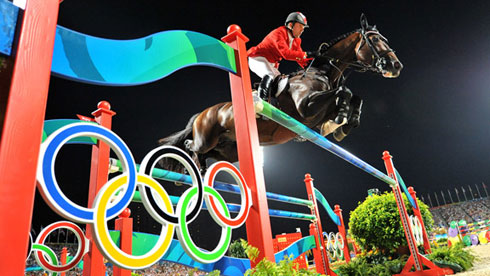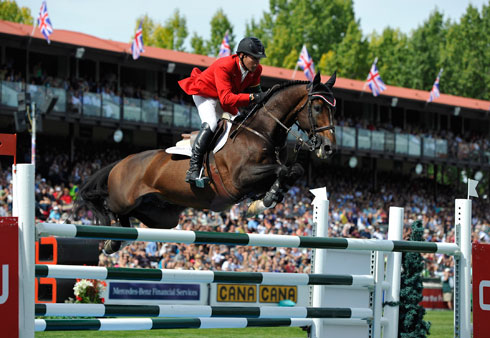Sport Mourns Loss of Mighty Stallion Hickstead
By Paula Parisi November 7, 2011
Eric Lamaze and Hickstead at the 2008 Olympics, where they won Individual Gold and Team Silver. (Photo by Kit Houton / FEI)
Show jumping lost a superstar on Nov. 6 when the stallion Hickstead collapsed and died during the fourth leg of the Rolex FEI World Cup Jumping 2011/2012 series at Verona, Italy. Drawn 22nd of 39 on the startlist, the horse has just completed Rolf Lundi’s 13-fence track with Canadian rider Eric Lamaze. The duo dropped a single rail and all seemed well, but as they made their way to the exit the horse slowly lowered itself to the ground.
“We finished our round, I circled and was leaving the ring, and he collapsed and died of an apparent heart attack,” said Lamaze, who was able to jump free and pull the reins over the horse’s head. “It is the most tragic thing that has ever happened. We had him until he was 15, and we had a great time together. He was the best horse in the world. We are all devastated.”
The competition was stopped at the request of the riders, and Lamaze’s fellow-competitors gathered in the Verona arena to pay their respects to one of the greatest horses of all time, and to support their colleague in his moment of loss with a minute’s silence.
Hickstead, a 16-hand Dutch Warmblood stallion, was named for the famous equestrian showground in Britain. By Hamlet out of the mare Jomara, Lamaze found the horse in Europe and urged his employer ― the Minnesota-based businessman and engineer John Fleischhacker, whose daughter, Ashley, Lamaze was hired to coach ― to purchase the horse for him to ride. They acquired Hickstead in 2004 as a coming seven-year-old.
“In the corporate world, it’s often said that your assets walk out the door at the end of the day – that the people are the real value in a business. It’s the same with horses,” said Fleischhacker in a 2009 interview. “The real asset is the relationship the rider develops with the horse. Neither one by themselves is worth much, but if you get the right combination, it’s magic.”
Magic is, by all accounts, what Lamaze eventually developed with Hickstead, but it wasn’t instant kismet. “The horse was young and needed a good deal of development. I remember we took him to Spruce Meadows and it was a trying time. The horse was difficult, at best. From there we just had to work on it – and work and work, year after year,” Fleischhacker recalled.
“There was talk periodically of selling him, but we hung in there and stuck with the program, and pretty soon Hickstead started to shift his enthusiasm more toward show jumping and less toward wanting to just stand around and things took off.” In 2007 the horse and rider duo had their first significant wins – team silver and individual bronze medals at the 2007 Pan American Games.

Lamaze and Hickstead win the 2011 CN International $1 Million Grand Prix. (Photo by Kit Houghton / FEI)
Victories aboard Hickstead largely propelled Lamaze, 43, to his current position as the top ranked rider in the world on the Rolex/FEI charts. The duo won Individual Gold and Team Silver at the 2008 Olympics equestrian competition in Hong Kong. HorseCanada.com reported in February 2008 that the horse had had abdominal surgery for colic the prior year, from which he made a stellar recovery.
The duo was individually first-placed at the World Equestrian Games in October 2010 after four fault-free rounds. As a result, Lamaze and Fleischhacker ― who wound up co-owning the horse so Lamaze could compete on the Canadian national team ― were named FEI Owners of the Year for the second consecutive year by the Show Jumping Owners Club. Riding Hickstead Lamaze won the CN $1 Million International Grand Prix at Calgary’s Spruce Meadows Masters Tournament in 2007 and also in September, at which point Lamaze told reporters, “I know him very well, and he wants to jump clear just as much as I do.”
The owners had begun pulling semen and breeding him over the past two years, and Hickstead already has babies on the ground. Since he was still actively competing, Lamaze was very careful as to when he could be drawn, and the gathers are limited.
Had he lived, he would no doubt have had a multimillion dollar breeding career ahead of him. A stallion can breed into its 20s, while prime competitive years are 9 or 10 through 14 or 15. (While 15 is not considered “young,” it is hardly over the hill. Meredith Michaels-Beerbaum retired Shutterfly this year at 17, and Richard Spooner stabled his superstar Robinson at 21.)
Fédération Equestre Internationale President HRH Princess Haya, an Olympic competitor in 2000, added her condolences to those that have poured in since news of the horse’s death. “Hickstead really was a horse in a million and my heart goes out to Eric and everyone connected with this wonderful horse. This is a terrible loss, but Hickstead truly will never be forgotten. We were very lucky to have known him.”
FEI Jumping Director John Roche said the exact cause of death has not yet been officially determined, adding, “our deepest sympathies go out to the owners, to Eric and to all the connections of one of the greatest Jumping horses of all time. Hickstead’s presence on the circuit will be very sadly missed.”
Short URL: https://theequestriannews.com/?p=6562


